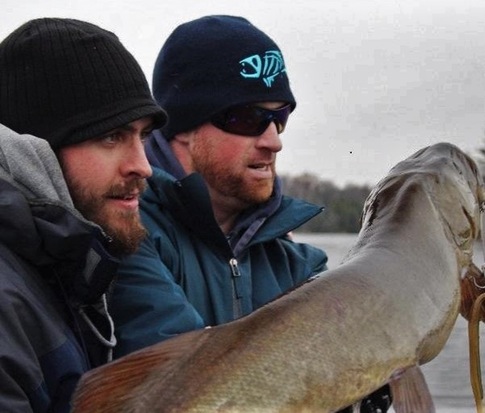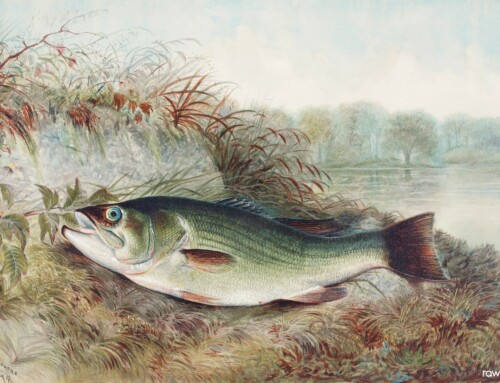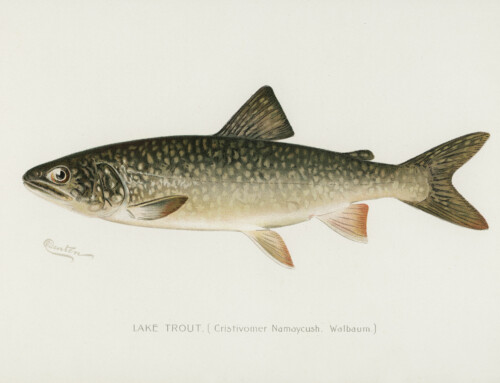Don’t throw in the towel just yet! Jamie Wilson explains the where, how, and why of late fall Musky Fishing.
Originally Published by Fishulo on Scout, November 27, 2015
By Jamie Wilson
Alright, there’s good news and bad news. I’ll give you the bad news first. The open water musky season is in its final stage. The good news is that you have an epic few weeks left to get it done, provided you are fishing in lakes and rivers in and around say, southern Ontario and other near north spots free of ice.
A lot of anglers have thrown in the towel by now and I ask why? This has been an unseasonably warm fall and looks to remain that way. If your favorite lakes start to freeze up, find some faster flowing rivers that will ultimately stay unfrozen much longer. A good example of this would be the Trent Severn waterway which has open dams creating current in river sections that bottle-neck between lakes. This current will be your friend in many ways, one of which is open water right into mid-December. Of course, the Great Lakes are a good option as they do not tend to freeze up, so launch your boat into the famous Lake St.Clair and get after it.

Chris Huskilson – existtofish.com
Let’s take look at the where, why’s and how’s when searching out productive areas for musky and how to get them to attack. Both Aaron Jolicoeur and Chris Huskilson lean on flowing tributaries in the Kawartha region of Ontario when on the hunt for hungry late fall musky and they are definitely dialed into what makes these toothy predators tic. Aaron explains “Don’t abandon aquatic vegetation/weeds that are brown and appear to be dead or dying as these weeds will continue to hold both suckers and bullheads”. You see, suckers and bullheads can thrive in environments low in oxygen and both species are fatty, delicious meal choices for musky.
Now, both Chris and Aaron favor a couple of lures and color choices to mimic these forage types, the first being a 10”-12” plastic tube mostly of the unweighted variety, along with jerk and glide type baits. Also, Chris has recently added a new tool to his box, the “Baby beaver” and “Baby Beaver XL” by Beaver’s Baits. These baits are a blend of rubber and hair that provides a very unique, subtle swimming action during the retrieve which can trigger the most negative fish. Color wise, to mimic suckers and bullhead, a dark brown gets the job done.

Beaver’s Baits XL Beaver
Another high percentage spot will be on breaklines which create current seams into slack water which are ambush points. Chris Huskilson explains “I’ll follow the breakline or contour line in the current with the trolling motor at 30% while casting ahead of the boat, then, I’ll retrieve the tube, “Baby Beaver” or a Manta on a slack line, with a twitch-pause cadence. I make sure to keep an eye on the GPS unit to better pinpoint the high percentage areas that hold baitfish and ultimately, opportunistic musky. I’ll follow these contour lines into current breaks and slack water, then I’ll fan cast that area before I move on”.
Other meals choices in the Kawarthas also include walleye and their cousins, yellow and jumbo perch. Musky Innovations “Titan Tubes” have some great color choices such as “Walleye” and two variations of “Perch”, one which has an orange belly and deeper contrast and the other being more muted and subtle in appearance. Now, rivers at this time of the year can be murky and stained which alters color choice. Aaron explains “In clear water I lean towards more natural colors like walleye, green pumpkin and sucker. When the waters become stained I will throw bright colored tubes in orange, chartreuse or even a combination of the two”. Musky Innovations also offers a couple matches for this situation such as “Sherbert” (orange/chartreuse) and “Cremesicle” (orange/white-speckled back).

Musky Innovations 12 inch Titan Tube Cisco
Beyond color choice, proper presentation is the key when fishing for musky. The proper use of “triggers” during the late fall period (and any time of year) is so important when you’re trying to turn the heads of these apex predators.
As water temperatures drop into the low 40’s the overall speed at which you work a bait changes from afaster twitch-twitch pause to a varied twitch-pause jerkbait style retrieve. The twitch will lift the bait and make it dart to the side then spiral down on the pause. The most important factor here when applying this type of trigger into a retrieve is the anglers ability to throw slack in line during twitches and pauses. Snapping/twitching on slack line, rather than pulling the bait on a taught line sends it into an erratic sideways darting motion, at which point, again with slack line on the pause, the bait will descend without being pulled into an arching motion towards the boat. These triggers in this presentation are natural representations of injured or dying forage, which top predators such as musky zero in on as an easy meal in the frigid waters of late fall.

River Run Tackles Original Manta
Both Aaron and Chris subscribe to this theory and presentation choice. Aaron explains “Tubes can be very unpredictable and erratic which lends itself to this time of year. Experimenting by varying the cadence can help to better predict patterns”. What this means is Aaron will change the timing or length of pauses to efficiently figure out the feeding response of albeit negative, neutral or downright aggressive fish. If tubes, which are a combination of vertical and horizontal presentations aren’t getting a positive response, the full on horizontal presentation of a jerkbait could very well be the next logical choice. The ability to suspend a jerkbait or glide bait in the strikezone for much longer periods of time in cold water can produce bites from finicky, negatively responding musky. One of the best glide baits out there for this application is the legendary “Manta” by RiverRun Tackle. The same cadence rules apply to this bait, just experiment until you find the magic combination of color and speed along with erratic vs steady action, depth and location.
Other ways to further predict the response you may get from these often misunderstood fish could include barometer and moon phases. Some anglers don’t pay attention to either one and some keep both factors in mind. A falling barometer can get all the baitfish in the system a bit more active meaning it is possible that a faster cadence and a more erratic, aggressive retrieve might be the deal, while the opposite may be true on a high pressure raising barometer. Moon phases can also have something to do with activity levels as well as a full moon period, for example, can coincide with the highest activity levels on the calendar. Keep in mind, musky might not have read the book on this so again, you need to read the waters you’re on in conjunction with the prevailing conditions and experiment with the cadence until you can pattern the fish.

Muskie Innovations Double Dawg
Expanding on throwing plastics for late fall musky a bit, local Kawartha and Lake St. Clair hot stick and owner of Figure Ate Guide Service Sam Ecker can shed more light: “I throw Musky Innovations “Bulldawgs” all year, but when the water temps drop and/or there is high current I’ll cast the magnum version of the

Muskie Innovations Double Dawg
“Bulldawg”. Late fall it is magnums all the way in the Kawarthas. “Bulldawgs” can be fished much the same way as a tube. Lift-drop, twitch-pause is the order of the day. When I fish Lake St. Clair I’ll turn my attention to Musky Innovations “Shallow Invaders” in colors that mimic shad as this is the main forage base on this body of water”.

Musky Innovations Dyin Dawg
Now what about boat side maneuvers in all of this? Good question. This is the final “trigger” that will turn a follow into a bite. Weather it is “Titan Tubes”,

Musky Innovations Shallow Invader
“Bulldawgs”, “Shallow Invaders, “Manta” jerkbaits or “Baby Beavers”, you must be focused on boat side maneuvers. Twitch-pauses are a trigger, but there are a couple more very important triggers beyond that. Speeding up during the last 25% of the retrieve can trigger a bite as well. But when a musky is non-committal to this, a proper figure 8 which involves slowing down and raising the bait into a wide turn, then speeding up and plunging the bait on the straight away. You need to make them chase the bait and force them into a kneejerk reaction and thus making a decision, you know? This is the final trigger so if you get bit make sure your hooks are sharp, and you are focused and ready to set the hook into what could be the biggest fish of the season.

Sam Ecker- Figure Ate Guide Service
There is one more thing that can enhance the equation and that is the use of scent. Applying Liquid Mayhem baitfish scent is highly recommended as this creates a scent trail which adds to the realism of any lure as Liquid Mayhem is made with real baitfish. This will not only peak curiosity, but this might give you the extra second you need to set the hooks as the fish will hold on longer due to the yummy taste factor.
I’ll add this, the tackle is of utmost importance as musky are very powerful so make sure you can handle this aspect of the game. 8’6”-9’ XX heavy rods, coupled with wide arbor high quality reels spooled with 80lb braid paired with 100-150lb fluorocarbon leaders with high quality snaps are an absolute must.
This is it, time is running out but this is the time when the biggest, meanest, hungriest toothy critters are on the prowl and are putting on the feedbag so gear up and get after them. This is the time when the hunters become the hunted so let the fall Musky hunt continue.
See you out there.

Jamie Wilson Lead Writer/Editor
Author Bio: Jamie Wilson is a passionate lifelong multi-species angler specializing in both smallmouth and largemouth Bass. He is the lead author for Exist to Fish Canada and writer for such online publications as Angling Authority, Rahfish and now, Fishulo. Along with being a tournament angler, Jamie comes to us representing the Canadian Bass Angler Fan Page, and he is a staff member/promotional team member for Liquid Mayhem, Lake Fork Tackle, Rod Sox, Fizards, Easthill Outdoors, Riverrun Tackle, Musky Innovations, Bumblelure, Kamooki Lures ltd., and Bill’s Bait and Tackle. Jamie is also a prostaff memeber for the camera accessory company EZCam Post!







